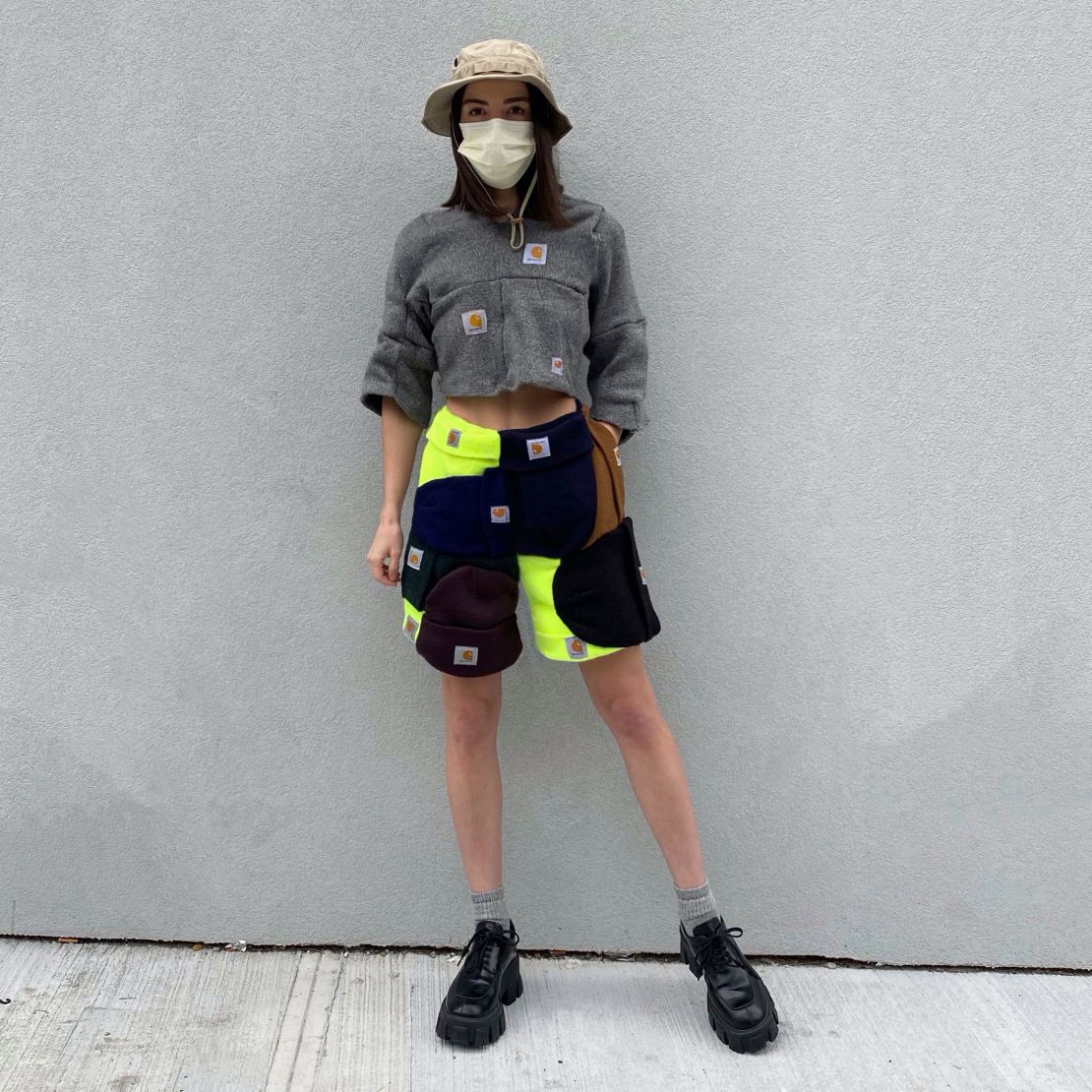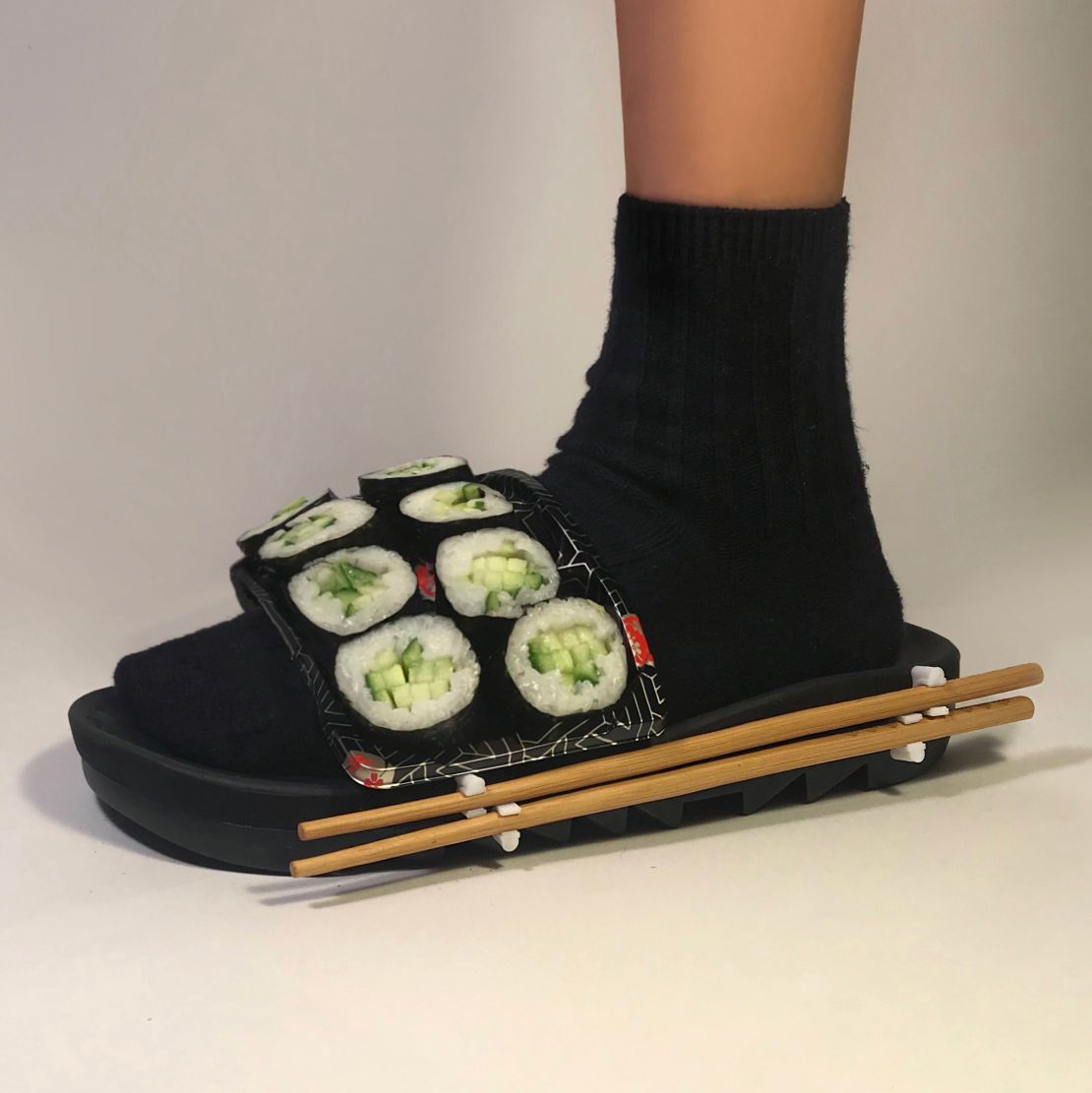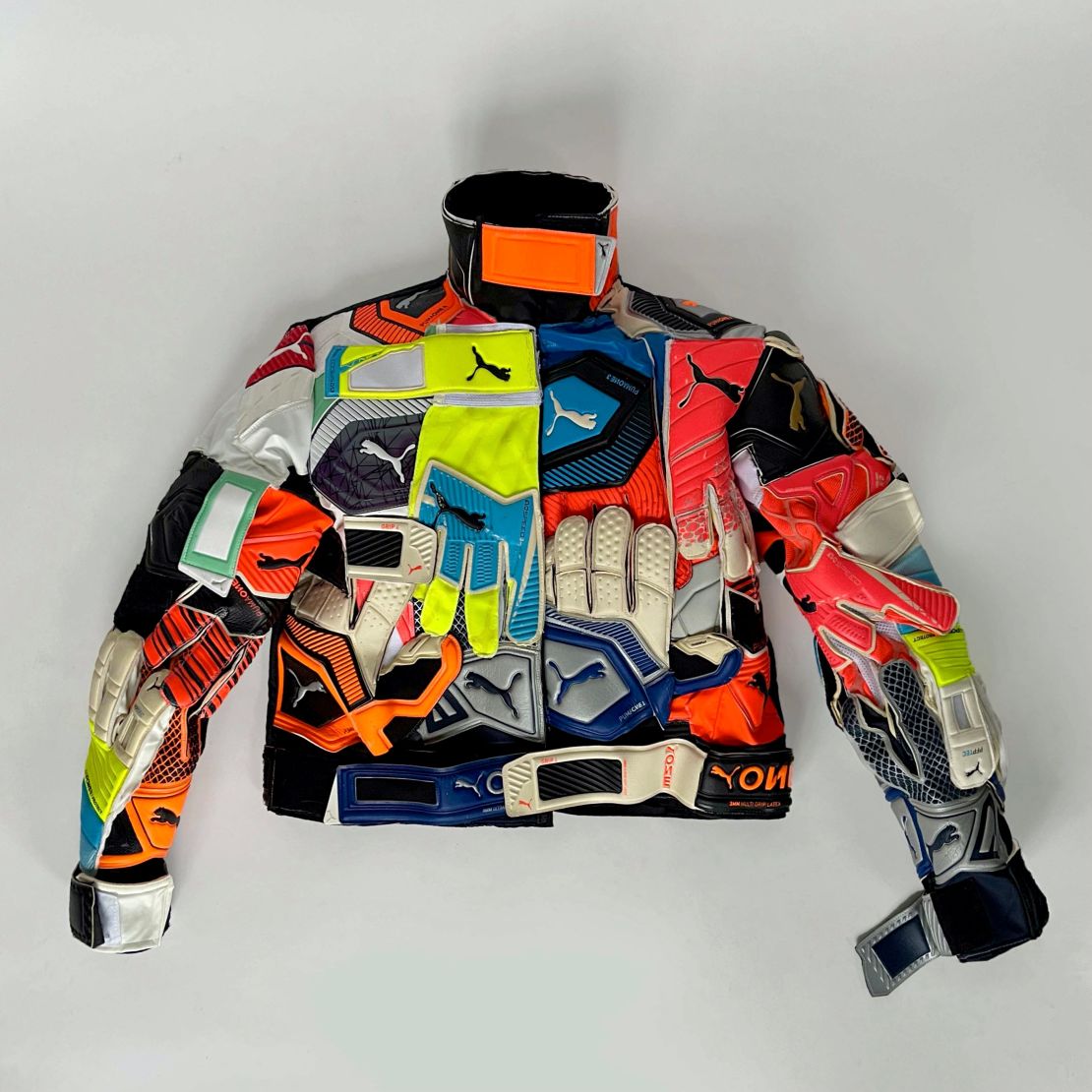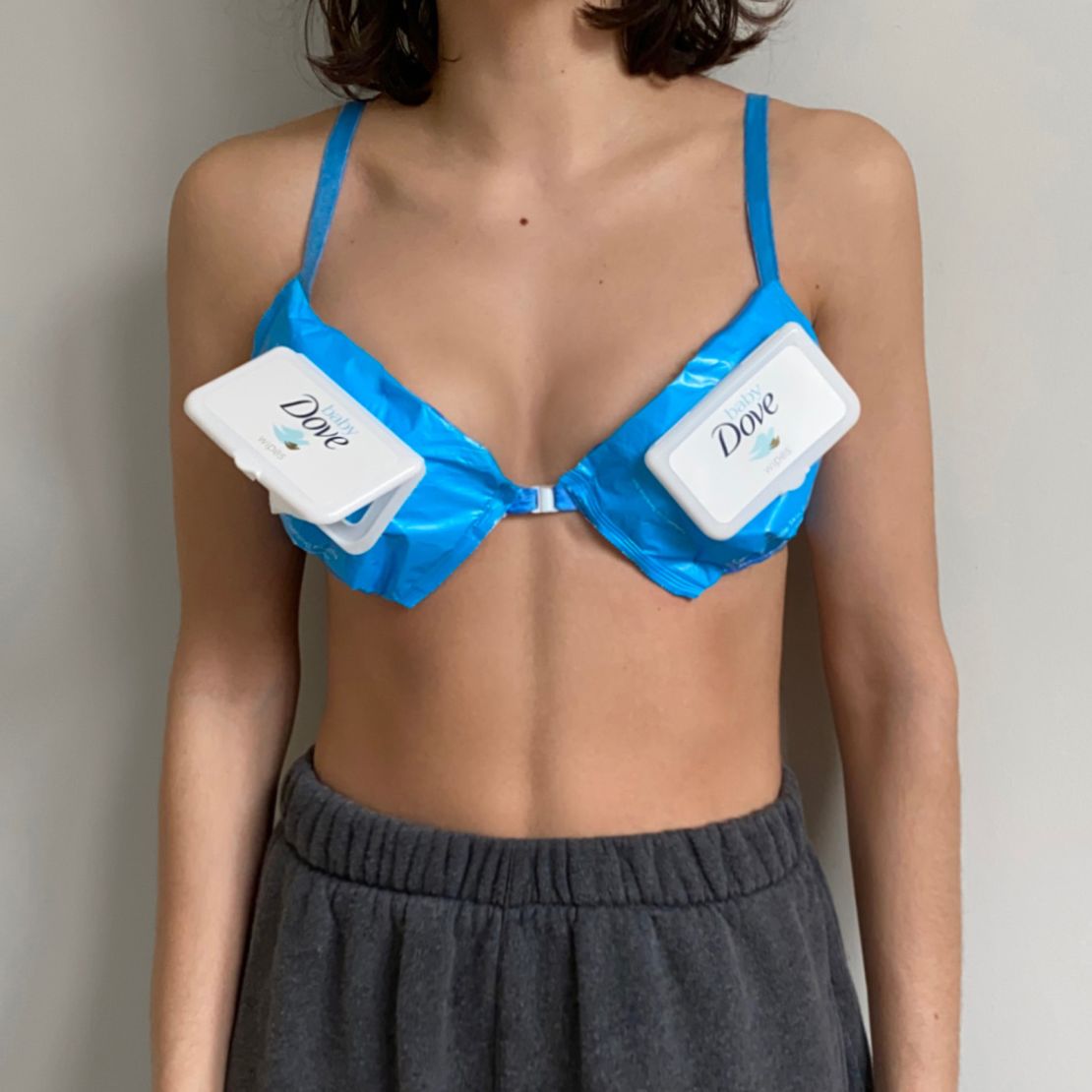On Instagram or TikTok, if you’ve seen a Dove wipe-dispensing bra, footwear made of tennis balls or a toasty bread hat with a Carhartt logo, you’ve probably spotted the handiwork of Nicole McLaughlin. Making one-off garments out of everyday products and upcycled streetwear, the Brooklyn-based designer gives each of her playful pieces a new function.
Over the past two years, McLaughlin has amassed hundreds of thousands of followers with her designs that range from from unexpected (please ask before you take a wipe from her bra) to wonderfully impractical, like a “shoeshi” sandal with a takeout sushi tray for the strap.
And while McLaughlin’s tool-kit-holding thongs and a puffer vest made out of cereal packs spark joy, they also challenge us to rethink the items we own.
“We all have a lot of stuff,” McLaughlin said in a phone interview, adding that people often have a limited view of how their things can be used. “A jacket is a jacket, and it can’t be a pair of shoes or something else. And so I was like maybe I should try to break (those) because the more opportunity you give material, you’ll see so many different things come about.”

Fashion has a massive waste problem, with 80% of all clothes winding up landfilled or incinerated. And while brands bear much of the responsibility, consumers can help by buying less and wearing their clothes for longer. Upcycling old clothes into new ones has inspired thriving online communities with inspirational and instructional content on YouTube, Pinterest and TikTok – on TikTok alone, the hashtag has nearly 6 billion views. Users restyle old sweaters, teach viewers how to hand embroider ripped clothing, and transform thrifted garments, embracing upcycling’s unique results as well as its eco-conscious benefits.
As for her own practice, McLaughlin began her upcycling projects in her off-hours as a former graphic designer for Reebok, where she saw firsthand just how many samples were being discarded. So she began taking some of them home to disassemble and reassemble the designs, then posted the results on her social media accounts.

“When you take something apart and almost dissect it from the inside out, you realize how much goes into these pieces,” she said. “And a lot of the time, if something’s made in a factory, we take it for granted, especially when it comes to fast fashion, because it’s so cheap.”
Her first viral post was of cozy-yet-surreal sneaker made of cut-open tennis balls, reminiscent of the bulky shape of a Yeezy foam runner.
“It checked a bunch of boxes. It was comfortable, the colors were nice, it was wearable and durable,” she recalled. “And I was like, ‘I think I have something with this.’”
Intuitive designs
Since her earliest experiments, McLaughlin has picked up technical skills in sewing from friends and family and committed to her studio full-time. She doesn’t sell her designs (most of them she takes apart again to reuse the materials), but she’s worked with Crocs and her former employer, Reebok, to produce upcycled collections. Some of her garments have been worn by celebrities, though, with model Kristen McMenamy donning a coat made of Puma gloves on the cover of British Vogue in December, while Puerto Rican rapper Jhay Cortez wore her shoe vest in a music video last fall.
McLaughlin gets paid by brands to upcycle their products for her social media channels. Her partners have included Arc’teryx, Puma and Camelbak, and when they send her samples or excess inventory to work with, she says coming up with new designs is an intuitive process.

“I put it on my body and try to sculpt something out of that,” she explained. “If it’s sporting equipment, then I’ll put it on my foot and see if it creates some type of shape, or put it on my head and see if I can make a hat out of it.”
For independent projects, she goes thrifting for materials to upcycle, looking for items that have unique features, particularly from wear and tear.
“I actually prefer to find things that are pretty damaged or beat up because it’s a good starting point for me,” she said. “If it has a hole or a stain on it, I can…incorporate it into the piece.”
But she also likes to maximize the use of each item across one or more projects, so the more details – like hoods, pockets and zippers – the better. Oversized pockets feature prominently on her designs, which she says is likely a “subconscious f-you” to the brands that remove them from women’s clothes to save money.
“I get really mad when you buy something and it has no pockets, or it has those fake pockets,” she commented. “Every woman needs pockets to carry their stuff…I’m putting pockets on everything now, including bras.”
Wider change
McLaughlin has become a point person for brands to turn to with their overstocked products, and though she often directs them to fashion design programs that need materials, she says this year she’ll be building a nonprofit for a more formal way to assist the brands with whom she works.
“It’s been a really interesting experience to be able to work with brands who don’t typically upcycle things at all,” she said. “It’s not really feasible for them to take secondhand material and to try to find a way to use it again.”
In her own workshops, which she’s hosted with Cooper Hewitt, Smithsonian Design Museum, in New York, McLaughlin tasks students with building footwear with only a sole as the starting point, upcycling something from their own closet, or sifting through their trash – like the unconventional materials challenges from “Project Runway,” but with sustainability in mind.

She loves teaching others how to upcycle because everyone will approach the same prompt differently, she said.
“There’s room for everybody to join in on (upcycling) because we need people to do it. There is so much stuff that we need to try to figure out how to use in a different way,” she said. “And everyone’s executions are going to be so different.”
For those who want to get started, she said, “you don’t need to be an expert at sewing to be able to alter things.” It could be as simple as cropping an old T-shirt, she added.
“Start in your closet, go through the stuff that you’ve kept for a long time and didn’t get rid of for a reason,” she advised. “Try to figure out what it is about it that would make you want to use it again. What do you like about it? Is it the texture of it – like if it’s like a fleece, but it doesn’t fit you anymore? Could you take the sleeves off of it and put them together to make a bag? And then you have a vest from it, too.”
While your first projects may not be as involved as McLaughlin’s hydrating jacket made out of Camelbak reservoirs, or as outlandish as her croissant bra, rethinking any older piece of clothing is a solid start.


















